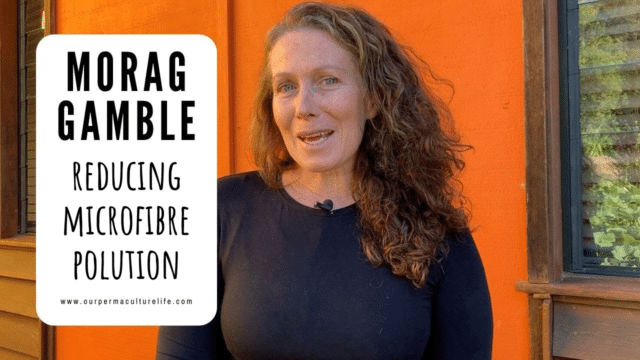How can you reduce the amount of plastic in the oceans by the way you choose and wash your clothing?
Each washing machine load of clothes can shed millions of micro-plastic fibres which cannot typically be filtered by the washing machine or sewage system. Especially if your clothes contain synthetic fabrics such as polyester, acrylic, nylon and fleeces. These fibres attract pollutants, oils, pesticides and become toxic in the waterways and enter the food web.
So here are my 4 simple tips that can make a difference.
To learn more about growing a permaculture garden simply and easily, check out our course The Incredible Edible Garden and learn how to design your own permaculture landscape in our Permaculture Design Course.

1. Limit wasting until required
A simple and effective option is to simply wash our clothes less. This is something that I learnt from my mum – She doesn’t actually wash after every time she’s worn something, she’ll spot clean if necessary. Of course, there are some clothes you need to wash after every use, but it’s about being mindful and knowing the difference. Because we simply don’t need to wash every piece of clothing after every use. Not to mention, washing your clothes less increases the life of the fabric, meaning that you can keep them for longer.
2. Contact the companies
You could also try writing to those companies who are making plastic-based fabrics. This can encourage them to take on the challenge and make different kinds of fabrics that aren’t going to shed quite as much. As we know, consumers do have a lot of power to change the habits of big companies.
3. Use filters or bags when washing
This is an excellent option for those who can’t quite afford clothes without microfibre and need to wash often. There are many filters, bags and washing balls on the market that stop microfibers from entering our waterways when we wash our clothes. I recommend heading to your local bulk store or eco-friendly retailer and asking for their products.
4. Select clothing that is compostable
There are a few clothing materials that we can buy, which don’t include micro-plastics that pollute our waterways. For example, cotton is natural, compostable and biodegradable, meaning that any micro-organisms that come from it won’t be as harmful. Other options are coir, linen, hemp, flax, wool, silk and there are many more.
Interested in learning more? I recommend checking out The Story of Stuff’s short film about Micro-fibre. It’s a 2 minute watch that talks you through how this problem can be solved when we all do our part.
Do you have another method for reducing micro-fibre pollution from your clothes?
Thank you for reading. Enjoy and please share.



Thanks for this article! (I have just bought a GuppyFriend filter bag)
One comment about composting clothing… I have composted (actually worm farmed) quite a few items. One must remember that the thread that is used to sew the clothes and any other textile items together is very rarely if ever compostable… they are usually polyester. This sort of works in t-shirts as they use interlocking stitching to sew the garments and you then out pull the long chain of threads that the worms have ignored… (it is likely though that it has shed some microplastic).
The worst mistake I made was to put a woollen shirt in the worm farm with its stiff collar and cuffs which was made of compressed polyester fibre… as it was wetted in the worm farm it expanded and I was picking out fine fibres for about 2 years – it took me a while to realize where it came from.
So to prevent any risk of non-compostables in my worm farm (or compost) I cut off all seams and hems, and anywhere there is stitching such as pockets (this sadly must go to landfill). I also cut off any stiffened cuffs, waistbands or collars. and remove all elastic as well. It can take a bit of time but worth it in the end… hopefully, more items will be using compostable threads soon.
PS if you are keen you could actually unpick the items but that is a time-consuming task.